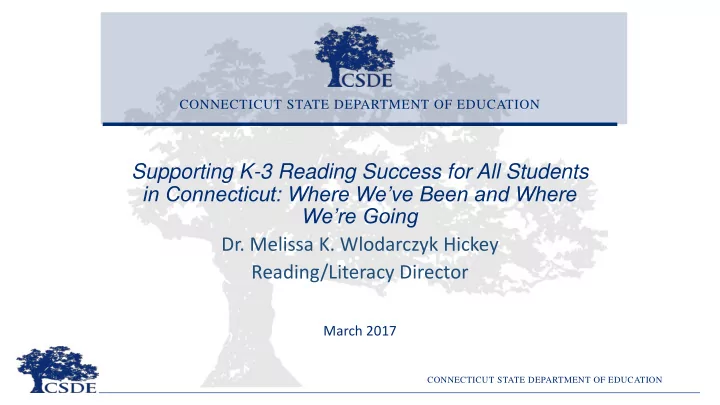

CONNECTICUT STATE DEPARTMENT OF EDUCATION Supporting K-3 Reading Success for All Students in Connecticut: Where We’ve Been and Where We’re Going Dr. Melissa K. Wlodarczyk Hickey Reading/Literacy Director March 2017 CONNECTICUT STATE DEPARTMENT OF EDUCATION
“Twenty Six Letters" by Earl Mills \https://www.arts.gov/art-works/2014/fighting-illiteracy-one-poem- time CONNECTICUT STATE DEPARTMENT OF EDUCATION
National Statistics about Illiteracy • One child in four grows up without knowing how to read. • By grade 4 a significant discrepancy exists between the reading comprehension proficiency of white students and their black and Hispanic peers and this discrepancy continues through grade 12. • 85% of all juveniles who interface with the juvenile court system are functionally illiterate. Over 70% of inmates in America's prisons cannot read above a fourth grade level. CONNECTICUT STATE DEPARTMENT OF EDUCATION
Strong Partnerships • Black and Puerto Rican Caucus • Commission on Women, Children and Seniors • University of Connecticut • Literacy How and Hill for Literacy CONNECTICUT STATE DEPARTMENT OF EDUCATION
Connecticut Growth • Year after year the data from the CT K-3 reading model work suggest a positive impact on schools and on children • Students experience greater growth in early literacy skills across grade levels and across literacy measures when their school implements CT’s K -3 reading model. • Demonstration schools have more than doubled the number of students meeting grade level literacy goals and more than halved the number of students at significant risk for reading failure. • The 2015-16 Smarter Balanced Assessment data show that in ELA, all Alliance Districts improved; fifteen Alliance Districts improved greater than the state. CONNECTICUT STATE DEPARTMENT OF EDUCATION
Erik’s Thoughts CONNECTICUT STATE DEPARTMENT OF EDUCATION
Allysen’s Thoughts CONNECTICUT STATE DEPARTMENT OF EDUCATION
Gavin’s Thoughts CONNECTICUT STATE DEPARTMENT OF EDUCATION
Connecticut’s Mission and Vision for Reading Achievement • Mission : The State of Connecticut is committed to developing coordinated systems of reading instruction through which children have access to structures and supports necessary to become fully literate. • Vision : The goal of the Connecticut State Department of Education (CSDE) is to ensure all Connecticut students will be proficient, engaged and active readers (at or above grade level) by the end of Grade 3 prepared for greater academic challenges and ultimately graduate from high school as responsible global citizens prepared to contribute to their communities and succeed in college, career and civic life. CONNECTICUT STATE DEPARTMENT OF EDUCATION
Systems of Effective Reading Instruction • Instructional leadership and commitment • K-3 literacy as the school’s priority • Establish a school literacy team • Build capacity and structures • Scientifically-based assessments • Parent Engagement CONNECTICUT STATE DEPARTMENT OF EDUCATION
Ensuring Equity and Excellence for All Connecticut Students The Connecticut State Board of Education’s Five -Year Comprehensive Plan, 2016-21 The CSDE will continue to collaborate with our partners to: • Expand the Connecticut K-3 reading model to more schools and districts • Support districts in understanding K-3 literacy standards, valid and reliable reading assessments, and utilizing student assessment data to drive research-based reading instruction • Assist districts in evaluating current literacy practices (including interventions and materials) and building the infrastructure/conditions necessary to sustain effective literacy practices over time CONNECTICUT STATE DEPARTMENT OF EDUCATION
Karina’s Thoughts CONNECTICUT STATE DEPARTMENT OF EDUCATION
Recommend
More recommend